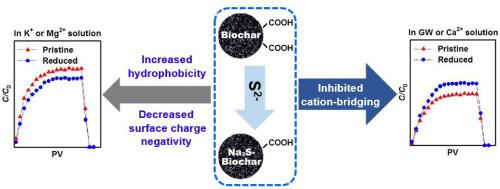当前位置:
X-MOL 学术
›
Environ. Pollut.
›
论文详情
Our official English website, www.x-mol.net, welcomes your
feedback! (Note: you will need to create a separate account there.)
Sulfide reduction can significantly enhance transport of biochar fine particles in saturated porous medium.
Environmental Pollution ( IF 7.6 ) Pub Date : 2020-03-30 , DOI: 10.1016/j.envpol.2020.114445 Pengkun Ma 1 , Wei Chen 1
Environmental Pollution ( IF 7.6 ) Pub Date : 2020-03-30 , DOI: 10.1016/j.envpol.2020.114445 Pengkun Ma 1 , Wei Chen 1
Affiliation

|
The release of fine particles from biochar materials applied in the environment may have important environmental implications, such as mobilization of environmental contaminants. In natural environments biochar fine particles can undergo various transformation processes, which may change their surface chemistry and consequently, the mobility of the particles. Here, we show that sulfide reduction can significantly alter the transport of wheat-straw- and pine-wood-derived biochar fine particles in saturated porous media. Counterintuitively, the sulfide-reduced biochar particles exhibited greater mobility in artificial groundwater than their non-reduced counterparts, even though reduction led to decrease of surface charge negativity and increase of hydrophobicity (from the removal of surface O-functional groups), both should favor particle deposition, as predicted based on extended Derjaguin-Landau-Verwey-Overbeek (XDLVO) theory. Using transport experiments conducted in single-cation background solutions containing K+, Mg2+ or Ca2+ under different pH conditions, we show that the surprisingly greater mobility of sulfide-reduced biochar particles was attributable to the removal of surface carboxyl groups during reduction, as this markedly alleviated particle deposition through cation bridging, wherein Ca2+ acted as the bridging agent in linking the surface O-functional groups of biochar particles and quartz sand. These findings show the critical roles of surface properties in dictating the mobility of biochar fine particles and call for further understanding of their transport properties, which apparently cannot be simply extrapolated based on the findings of other (engineered) carbonaceous nanomaterials.
中文翻译:

硫化物的还原可以显着增强生物炭细颗粒在饱和多孔介质中的传输。
从应用于环境的生物炭材料中释放细颗粒可能会对环境产生重要影响,例如动员环境污染物。在自然环境中,生物炭细颗粒可以经历各种转化过程,这可能会改变其表面化学性质,从而改变颗粒的迁移率。在这里,我们表明硫化物的还原可以显着改变小麦秸秆和松木来源的生物炭细颗粒在饱和多孔介质中的运输。违反直觉的是,硫化物还原的生物炭颗粒在人造地下水中的迁移率要比非还原的生物炭颗粒高,即使还原导致表面电荷负性降低和疏水性增加(由于去除了表面O-官能团),两者都应颗粒沉积 根据扩展的Derjaguin-Landau-Verwey-Overbeek(XDLVO)理论进行预测。使用在不同pH条件下在含有K +,Mg2 +或Ca2 +的单阳离子背景溶液中进行的迁移实验,我们表明,硫化物还原的生物炭颗粒出乎意料的更大迁移率归因于还原过程中表面羧基的去除,因为这可以明显缓解通过阳离子桥接沉积颗粒,其中Ca2 +在连接生物炭颗粒的表面O-官能团与石英砂的连接中充当桥接剂。这些发现表明,表面性质在决定生物炭细颗粒的迁移性方面起着至关重要的作用,并要求进一步了解其运输性质,
更新日期:2020-04-20
中文翻译:

硫化物的还原可以显着增强生物炭细颗粒在饱和多孔介质中的传输。
从应用于环境的生物炭材料中释放细颗粒可能会对环境产生重要影响,例如动员环境污染物。在自然环境中,生物炭细颗粒可以经历各种转化过程,这可能会改变其表面化学性质,从而改变颗粒的迁移率。在这里,我们表明硫化物的还原可以显着改变小麦秸秆和松木来源的生物炭细颗粒在饱和多孔介质中的运输。违反直觉的是,硫化物还原的生物炭颗粒在人造地下水中的迁移率要比非还原的生物炭颗粒高,即使还原导致表面电荷负性降低和疏水性增加(由于去除了表面O-官能团),两者都应颗粒沉积 根据扩展的Derjaguin-Landau-Verwey-Overbeek(XDLVO)理论进行预测。使用在不同pH条件下在含有K +,Mg2 +或Ca2 +的单阳离子背景溶液中进行的迁移实验,我们表明,硫化物还原的生物炭颗粒出乎意料的更大迁移率归因于还原过程中表面羧基的去除,因为这可以明显缓解通过阳离子桥接沉积颗粒,其中Ca2 +在连接生物炭颗粒的表面O-官能团与石英砂的连接中充当桥接剂。这些发现表明,表面性质在决定生物炭细颗粒的迁移性方面起着至关重要的作用,并要求进一步了解其运输性质,










































 京公网安备 11010802027423号
京公网安备 11010802027423号